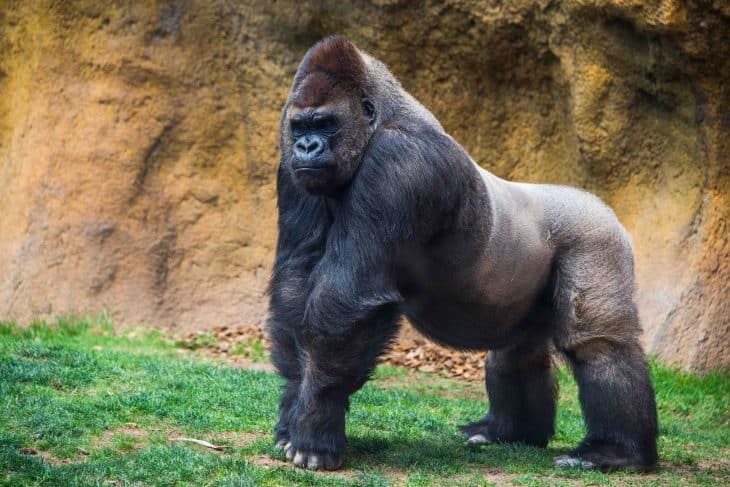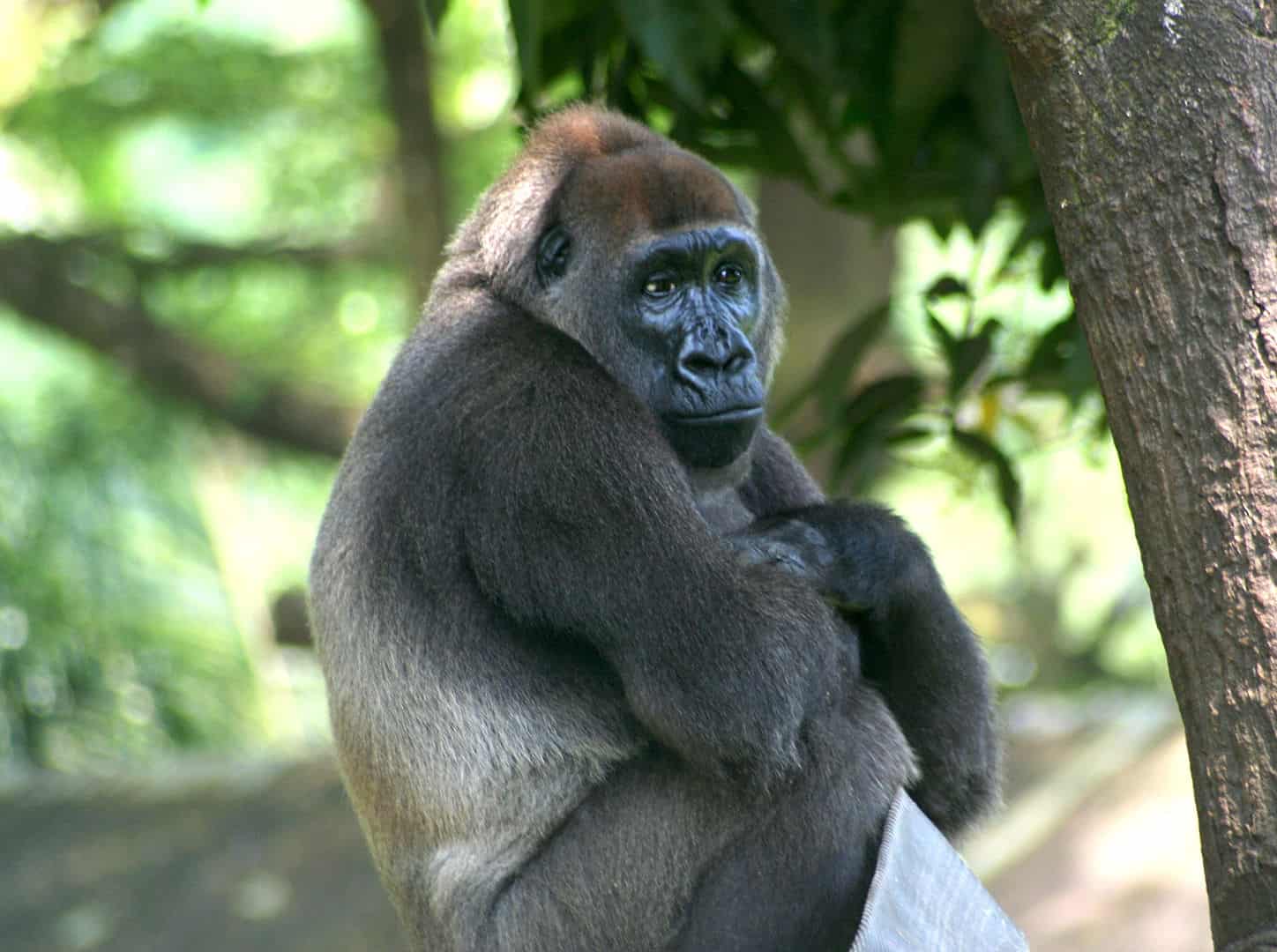
Gorillas make up one of humanity’s closest relatives as a species, more so than monkeys, even. In fact, lumping gorillas right next to monkeys insults these intelligent and even sophisticated animals. Out of all the gorilla facts out there, this one may be hard for people to accept. But it is 100 percent true!
Gorillas have similar senses to humans: their sense of smell, vision, and taste are all quite comparable. Humans, on the other hand, are known to appreciate the flavor of meat, but gorillas are strictly vegetarian. Gorillas make a variety of sounds to communicate: just like humans, gorillas can make a range of sounds to communicate and convey emotion. The gorilla has the ability to laugh, weep, and scream, as well as emit a sound called a “belch vocalization” to signal its presence in a densely forested environment. Due to similar genetics, many of the same diseases that affect humans also harm gorillas. In fact, travelers that have symptoms of infectious sickness, are not allowed to go gorilla trekking in Rwanda or Uganda.
There are many other, really interesting things about gorillas. Take this for instance- the power of the gorilla is legendary, especially when it comes to the upper body. In fact, a gorilla’s strength is nearly six times that of a human. So, if you ever come across an angry gorilla, the best thing for you to do is run! The fact that gorillas still use their upper bodies to move around and support their vast weight accounts for their arm, chest, and back burliness.
Here’s another interesting bit of info – surprisingly, gorillas rarely require fresh water to stay hydrated. They obtain enough moisture from the food they eat and the morning dew on their skin. Learn more about them with these 40 Gorilla Facts.
- On average, gorillas and humans share around 97% of their DNA.
- Gorillas average between 1.25 and 1.8 meters in height.
- Their weight also averages between 100 and 270 kilograms.
- At a maximum, their arm spans can reach up to 2.6 meters from one hand to the other.
- On average, gorillas in the wild live up to between 35 and 40 years.
- Humans and gorillas both share a common ancestor from 7 million years ago.
- The gorilla species diverged from each other around 260,000 years ago.
- The Carthaginian explorer Hanno the Navigator first discovered gorillas in 500 BC.
- He gave them their original name, “gorillae,” which later evolved into their modern name, gorilla.
- He also sent the skinned fur of gorilla females back to his home city of Carthage.
- Thomas Savage and Jeffries Wyman first differentiated the gorilla species in 1847.
- Paul Du Chaillu brought dead gorillas to Britain for study in 1861.
- Carl Akeley began the first systematic studies of gorillas in the 1920s.
- George Schaller pioneered field studies of gorillas after World War 2.
- In the late-20th Century, American conservationist Dian Fossey disproved many myths about gorillas.
- The oldest gorilla that ever lived, lived up to 60 years old.
- On average, captive gorillas live up to around 50 years old.
- Gorilla blood has similarities to human type O blood.
- Some scientists argue that like humans, most gorillas have a dominant right hand.
- Other scientists instead argue that gorillas don’t have either a dominant left or right hand.
Gorillas live across Africa.
Generally, gorillas live in the tropical and subtropical forest regions of Africa. In the east, that includes the Albertine Rift cloud forests of the Virunga Volcanoes, reaching up to a height of 4.3 kilograms. Most gorillas, though, live in the floor layer of rainforests, as well as in wetland swamps and marshes.
Gorillas have 2 different species.
Specifically, the western and eastern gorillas, which scientists further into two additional subspecies, each. The western gorilla includes both the western lowland gorilla and the Cross River gorilla. As for the eastern gorilla, they include the mountain gorilla and the eastern lowland gorilla.
Most zoos keep the western lowland gorilla.
The only exceptions include the Antwerp Zoo in the Netherlands, which keeps an eastern lowland gorilla named Amahoro. Zaire also keeps a small number of eastern lowland gorillas in captivity in their country.
A western lowland gorilla had the name Snowflake.
He also had the distinction of being the only known albino gorilla in the world, with records pointing to the rest of Snowflake’s troop all having normal coloration. A hunter named Benito Mañé caught Snowflake in 1966 in then-Spanish Guinea, but killed the rest of his troop. Mañé named him “Nfumu Ngui,” or “White Gorilla,” in the indigenous Fang language, and kept him for a few days.
However, he soon sold the gorilla to a primatologist named Jordi Pi, who then renamed the gorilla “Copito de Nieve,” which means Little Snowflake. He then put Snowflake in the Barcelona Zoo, where he lived until his death from skin cancer in 2003.

At that time, he had 22 children with 3 different mates, of whom 6 survived to adulthood. None of Snowflake’s children inherited his albinism, but one of his great-grandchildren has pink fingers, which scientists think could point to partial albinism.
The Human Immunodeficiency Virus (HIV) might have originated from western lowland gorillas.
Scientists base this on genetic similarities between the Simian Immunodeficiency Virus (SIV) and the HIV virus. Both cause the same disease, Acquired Immuno-Deficiency Syndrome (AIDS), in infected individuals. To differentiate between the human and non-human variants of the disease, scientists add simian to AIDS (SAIDS).
Research has also proven that SAIDS may have existed as far back as 32,000 years ago. This only strengthens the theory that HIV/AIDS originally infected gorillas and other apes. How it managed to cross the species barrier to infect humans remains unknown at this time, with scientists continuing to study the issue.
Cross River gorillas make up the world’s rarest apes.
As of 2014, only 250 adult Cross River gorillas remain in the world, scattered across an area of 12,000 km² along the Nigerian-Cameroon border. This area includes the headwaters of the Cross River, from which the gorillas get their name.
Although circumstantial evidence points to a possibly bigger population than currently recorded, the Cross River gorilla’s future remains questionable. This has led to international organizations giving them the “critically endangered species,” designation. It has also led to efforts between Nigeria and Cameroon to preserve the species as far back as 2001. These include Cameroon’s creation of the Takamanda National Park in 2008, linking up with the Cross River National Park in Nigeria across the border. Cameroon also created the Kagwene Gorilla Sanctuary that same year.

Mountain gorillas have strange fears.
For one thing, they’re afraid of some reptiles and insects, and avoid chameleons and caterpillars. Scientists have also observed mountain gorillas have a fear of water, only crossing streams if they can avoid getting wet in the process. This extends to rain as well, with mountain gorillas quickly looking for a way to get out of rain once it starts falling.
Eastern lowland gorillas suffer from inbreeding.
So much so, that scientists have observed a steady increase in birth defects across the species. Syndactyly, a condition where one or more fingers become fused together, proves particularly common among the observed defects. Scientists say this resulted from the small population of the eastern lowland gorillas, estimated at less than 4000 animals in 2016. This forces closely related animals to mate together, leading to an increased rate of birth defects in the offspring produced.
A gorilla’s physical features depend on where it’s from.
Eastern gorillas actually have darker fur than western gorillas, with the mountain gorilla subspecies having the darkest fur out of all gorillas. In contrast, it’s common to find western lowland gorillas with brown fur, and even red hair on their foreheads. Eastern gorillas also tend to have longer faces and bigger chests compared to their western cousins. Scientists still aren’t sure about the exact factors that led to the evolution of such traits.
Gorillas build nests.
Gorillas like to build them simple, out of branches and leaves, with the finished nest averaging between 0.6 and 1.5 meters across. Unlike other apes, gorillas prefer to build their nests on the ground, and not in trees, but exceptions do exist. Gorillas use their nests both to sleep at night, and to rest during the day. Gorillas also don’t build their own nests until they become 3 years old, before which they stay with their mothers.

Like their appearance, a gorillas’ diet depends on where it’s from.
Mountain gorillas primarily eat plant matter, such as leaves, pith, shoots, and stems, as well as small amounts of fruit. Eastern lowland gorillas have a similar diet, but eat more fruit compared to mountain gorillas, up to 25% based on scientific observation.
Western gorillas have a similar diet, but supplement their diet with aquatic plant life. Both western gorillas and eastern lowland gorillas also eat insects, such as ants. All gorillas also don’t commonly drink water, instead getting most of their water needs from the plants they eat.
Gorillas live in troops.
Troops on average usually number around 30 gorillas, led by a male called a silverback. The name comes from how the hair on the back of the dominant male gorilla develops a silver color.
To avoid inbreeding, young gorillas, whether male or female, tend to leave the troop they get born into on reaching adulthood. They then either join other troops or form troops of their own.
When a troop’s silverback dies or gets killed, then the troop disbands, its members joining other troops, or forming new troops of their own. Sometimes, though, one of a troop’s younger males takes over as the new silverback, with the troop staying together as a result.
Gorillas have complex behaviors in a troop.
Silverbacks make many important decisions, such as when and where the troop migrates. They also defend the troop against predators or even against other troops, as well as mediating arguments inside the troop. Younger males in the troop provide additional protection for the troop. Relationships among female gorillas in a troop vary. Females related to each other tend to stay friendly with each other. Otherwise, they aggressively compete with and even fight against each other.
Gorillas have few predators.
In fact, humans make up the only confirmed predator of gorillas. Leopards may prey on gorillas based on fecal remains, but scientists see this as circumstantial. No records exist of leopards actually hunting, much less attacking gorillas except in self-defense. This leads them to think that gorilla remains in leopard feces could have resulted from leopards scavenging gorilla corpses.

It takes gorillas 10 years before they can start mating.
That said, females actually have their first period around the age of 6, they just can’t get pregnant until they reach the age of 10. Once they’ve fully matured, females typically have 30 day periods and stay pregnant for 8½ months before giving birth. While females can mate and get pregnant right after giving birth, they usually prefer to wait for about 4 years before doing so. In contrast, male gorillas can have children in adolescence, even before reaching full maturity.
Gorillas have unique sounds for communications.
Scientists have recorded 25 distinct vocalizations used by gorillas for communicating with each other when in dense vegetation. Scientists have also recorded grunts and barks used as signals when a troop travels across the countryside, or as a form of social discipline. Silverbacks also have distinct screams and roars when sounding the alarm or giving a warning.
They also engage in ritual display.
In particular, gorillas have one ritual display used as a form of intimidation to settle arguments without having to actually fight. It has nine steps, starting with a series of hoots, then symbolic feeding gestures, followed by standing on both feet before throwing plant matter at the opponent.
The gorilla then thumps their chest with clenched fists, before kicking out with a foot. Sideways running follows, first with only the hind feet, and then on all fours, followed by slapping and tearing at the surrounding plant life. Finally, they finish by thumping the surrounding ground. Usually, one or the other gorilla will retreat before all 9 steps get finished, otherwise, the argument turns physical.
Gorillas are also quite intelligent.
Gorillas in captivity have successfully learned how to communicate in sign language. In the wild, scientists have observed gorillas apparently show an understanding of humor amongst themselves, and even the capacity for long-term planning.
They’ve also observed gorillas using primitive tools, such as fallen trees as bridges, or to support themselves while fishing for underwater plant life. They also sometimes even use branches as clubs to smash open termite or ant hives.
Human development threatens the gorilla’s future.
Destruction of their habitat to make room for human development makes up the most visible threat humanity poses to the gorilla’s future. Less visible, but actually more damaging, involves the hunting of gorillas not simply for sport, but as bushmeat. Despite poaching becoming officially illegal, local governments actually tend to not enforce the ban, especially when people hunt gorillas for food.
Gorillas also find themselves vulnerable to diseases that also affect humans, such as ebola. In fact, an ebola outbreak in Zaire in 2004 killed hundreds of gorillas in the Odzala National Park. In 2006, scientists estimated that various localized outbreaks of the disease could have killed as many as 5,000 gorillas.
There have been movies about gorillas.
King Kong probably counts as the most iconic gorilla of them all, first featuring in the 1933 film of the same name. The film has received several sequels over the following decade, and received remakes twice, first in 1976, and again in 2005.
A reboot followed in 2017, and in 2021, found himself pitted against Godzilla. Outside of the King Kong franchise, gorillas have a leading role in the Tarzan franchise, as well as the Donkey Kong series of video games.

Was this page helpful?
Our commitment to delivering trustworthy and engaging content is at the heart of what we do. Each fact on our site is contributed by real users like you, bringing a wealth of diverse insights and information. To ensure the highest standards of accuracy and reliability, our dedicated editors meticulously review each submission. This process guarantees that the facts we share are not only fascinating but also credible. Trust in our commitment to quality and authenticity as you explore and learn with us.
